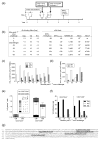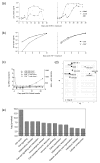High-level, lasting antiviral immunity induced by a bimodal AIDS vaccine and boosted by live-virus exposure: prevention of viremia
- PMID: 21941166
- PMCID: PMC3767758
- DOI: 10.1097/QAD.0b013e32834d3c4f
High-level, lasting antiviral immunity induced by a bimodal AIDS vaccine and boosted by live-virus exposure: prevention of viremia
Abstract
Objective: To characterize the correlates of protection from systemic infection in a vaccinated rhesus macaque, RAt-9, which had been challenged sequentially with two related clade C simian/human immunodeficiency viruses (SHIV-Cs) yet remained aviremic for more than 5 years despite indirect evidence of cryptic infection.
Design: To measure long-term anti-SHIV-C immunity, host genetics and gene-expression patterns for protective correlates.
Methods: Long-term immune reactivity was evaluated and identification of virus in RAt-9 was attempted by RT-PCR analysis of concentrated plasma and blood transfer to CD8(+) cell-depleted infant macaques. Full MHC genotyping of RAt-9, TRIM5α and KIR3DL allelic expression analysis of PBMC, and microarray gene expression analysis were performed.
Results: All attempts to detect/isolate virus, including blood transfer to CD8(+) cell-depleted infant rhesus macaques, were negative, and the animal maintained normal levels of memory CD4(+) T cells in both peripheral blood and gut tissues. However, RAt-9 maintained high levels of anti-SHIV-C humoral and cellular immunity, including reactivity to nonvaccine neoantigens (Nef and Rev), up to 63 months postinitial challenge, suggesting chronic sub-threshold infection. RAt-9 expressed the Mamu A*001 allele negative for B*008 and B*017, had a B13 serotype, and had increased expression of killer-cell immunoglobulin-like receptors (KIRs) previously linked to favorable outcomes of lentiviral infection. Elements of the gene expression profiling coincided with genotyping results. RAt-9 also displayed CD8 cell noncytotoxic antiviral response (CNAR) activity.
Conclusion: Monkey RAt-9 is the first example of a virus-exposed, persistently aviremic animal that has maintained long-term, high-level cellular and humoral antiviral immunity in the absence of an identifiable cryptic reservoir.
Figures


References
-
- Rerks-Ngarm S, Pitisuttithum P, Nitayaphan S, Kaewkungwal J, Chiu J, Paris R, et al. Vaccination with ALVAC and AIDSVAX to prevent HIV-1 infection in Thailand. N Engl J Med. 2009;361:2209–2220. - PubMed
-
- Mascola JR, Montefiori DC. The role of antibodies in HIV vaccines. Annu Rev Immunol. 2010;28:413–444. - PubMed
-
- Rasmussen RA, Ong H, Song R, Chenine AL, Ayash-Rashkovsky M, Hu SL, et al. Efficacy of a multigenic protein vaccine containing multimeric HIV gp160 against heterologous SHIV clade C challenges. AIDS. 2007;21:1841–1848. - PubMed
Publication types
MeSH terms
Substances
Grants and funding
LinkOut - more resources
Full Text Sources
Research Materials

